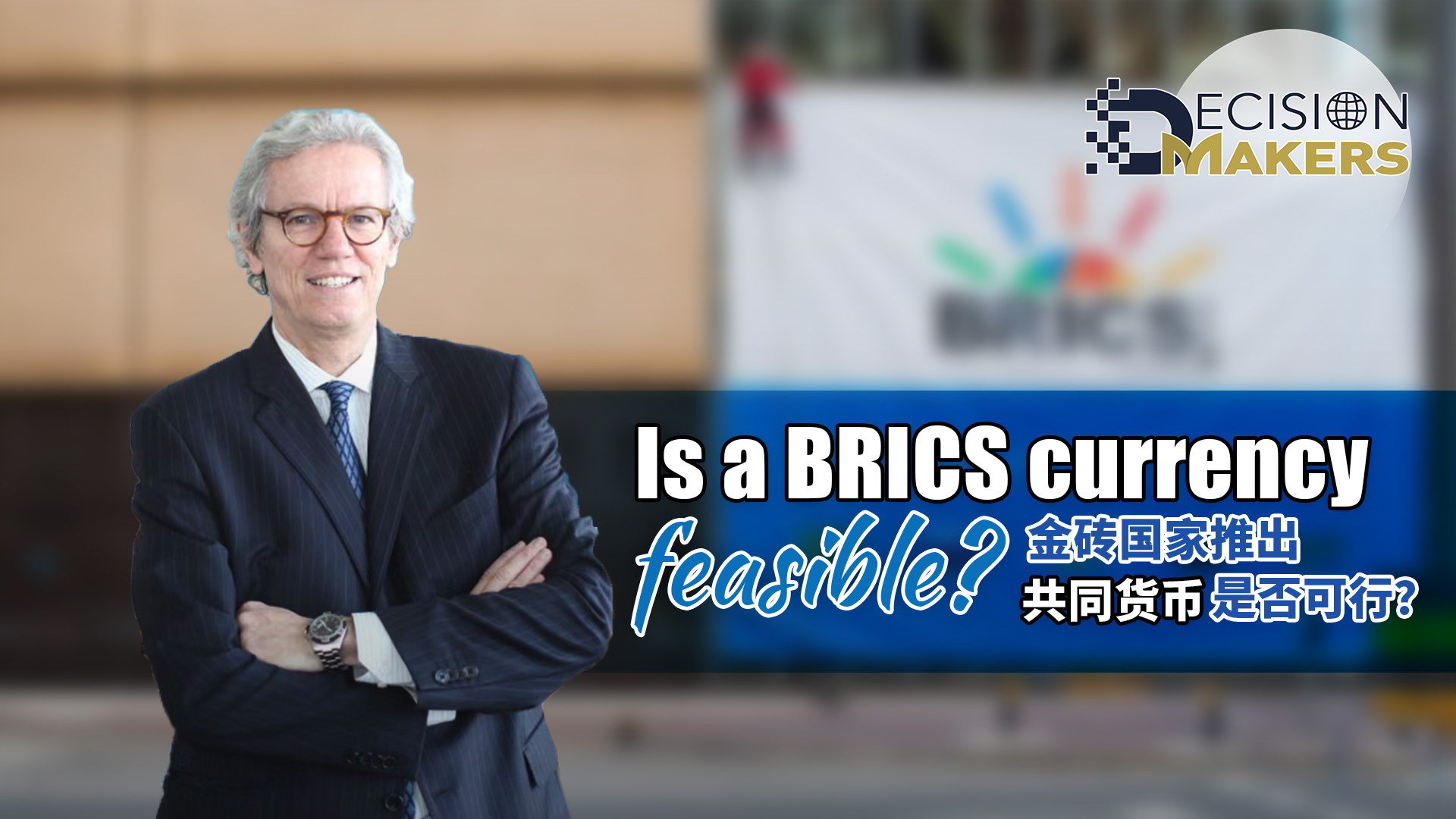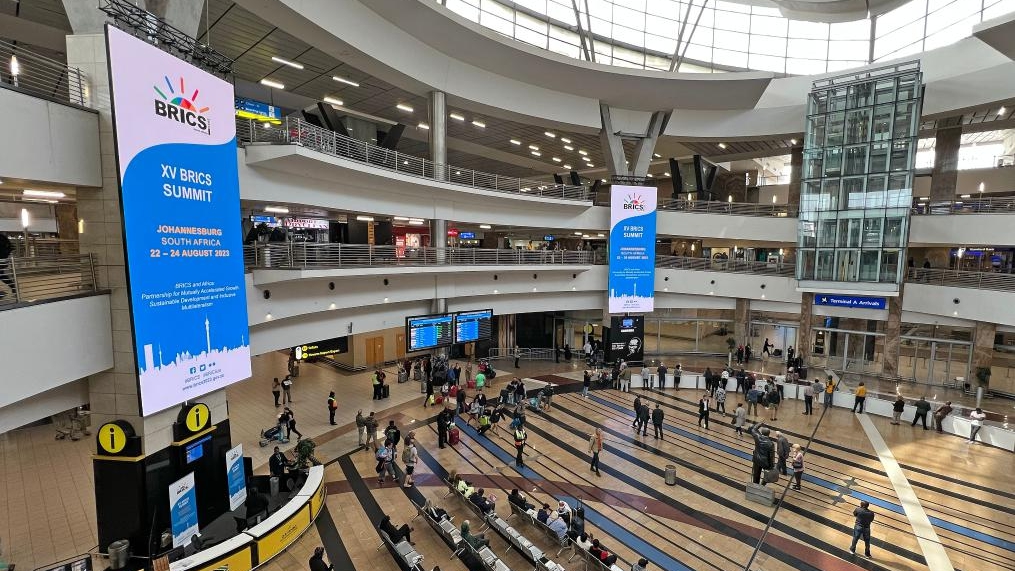
Editor's note: Decision Makers is a global platform for decision makers to share their insights on events shaping today's world. Paulo Nogueira Batista Jr., a Brazilian economist, is the former vice president of the New Development Bank and former executive director for Brazil and other countries in the International Monetary Fund. The article reflects the author's opinions and not necessarily the views of CGTN.
The possible creation of a currency by BRICS (Brazil, Russia, India, China and South Africa) has been frequently mentioned in the international media. The discussion has not been officially launched yet, but it should be present, in some form, at the summit of BRICS leaders that will take place in South Africa from August 22 to 24.
The background to this possible BRICS currency is the growing dysfunctionality of the international monetary system that, since World War II, has been based on the U.S. dollar. Its fundamental contradiction is that the international system depends predominantly on a national currency, managed according to the interests of the state that created it. However, nothing guarantees that U.S. priorities coincide with the broader interests of the international system that depends on the dollar.
More recently, the U.S. has been using its currency more and more aggressively to pursue political and geopolitical goals. The weaponization of the dollar, as well as of the euro, has been taking place – that is, the use of the national/international currency and of the Western financial system to target hostile countries or countries seen as hostile. Russia has been the latest target.
Around $300 billion of Russia's reserves invested in dollars and euros were simply frozen. Needless to say, the weaponization of the dollar has caused an erosion of confidence – and confidence is an indispensable requirement for any currency. In one sentence: The United States has become paradoxically the main enemy of the dollar as a world currency.
What paths could be taken towards a possible BRICS currency? The terrain is new for BRICS, and still unexplored by us. Only a few aspects will be addressed in this article, without attempting to present detailed proposals.
A curiosity: Russian officials noticed the following happy coincidence: the currencies of the five BRICS countries all start with the letter "R" – real, ruble, rupee, renminbi, and rand. They then proposed that the new currency be called R5.
The R5 would start as a unit of account, taking the form of a basket of the five currencies.
In this first stage, the R5 could be used as a unit of denomination for certain transactions and national official accounting records in addition to being adopted to replace the dollar in the internal accounting of the financial mechanisms created by BRICS – the New Development Bank and the Contingent Reserve Arrangement. This step is relatively simple and – if there is consensus among the five countries – could be implemented quickly and without significant costs.
The Russian proposal, as far as I know, does not go much further than this initial step. From here, there is vague talk of backing the R5 with gold or other commodities.

Electronic screens of the 15th BRICS summit are seen at the O.R. Tambo International Airport in Johannesburg, South Africa, August 16, 2023. /Xinhua
Electronic screens of the 15th BRICS summit are seen at the O.R. Tambo International Airport in Johannesburg, South Africa, August 16, 2023. /Xinhua
As is well known, a currency has to exercise not only the functions of a unit of account, but also those of a store of value and a means of payment. How could we ensure that the R5 would be able to fulfill all these functions? Who would be responsible for issuing the R5 and putting it into circulation? Would the R5 have a physical existence or would it only be digital? Would it be necessary to create a BRICS Central Bank and unify monetary policy? Would the R5 inspire confidence?
Let us briefly address some of these points.
First, it is not necessary for the R5 to have a physical existence. It could just be digital. Nor would it be necessary or even recommended to create a Central Bank of BRICS responsible for conducting monetary policy for the five countries, something impracticable for several reasons.
In other words, the purpose could not be to create a single currency that would replace the five national currencies. It would be enough to create an Issuing Bank in charge of issuing R5 according to predetermined rules without interfering with the actions of the five central banks who would continue to perform all the typical functions of monetary authorities.
How could the new currency be backed? Backing a currency means basing it on a solid asset, allowing it thereby to achieve widespread acceptance and circulation. For this backing to have real meaning, it is necessary that the backed currency be freely convertible into the backing asset at a fixed exchange rate.
One could conceive the following alternatives to back the R5: first, gold or other precious metals; second, other commodities or a basket of commodities; third, dollars and other internationally liquid currencies; fourth, some sort of financial backing provided by BRICS.
The first two options could hardly work in practice. The prices of gold, silver and any other commodities fluctuate sharply, leading to unpredictable variations in the value of the BRICS currency. The R5 would reflect the countless circumstances that affect the international gold, silver and commodity markets. It would fluctuate along with gold and other commodities and lose any ability to serve as a benchmark.
The third alternative is the model used in the case of the IMF's Special Drawing Rights (SDRs) that are backed by dollars and other major currencies. This means that SDR holders have the right to convert them freely into dollars and other currencies with international liquidity. Such a convertibility model would not be a solution for the R5.
Theoretically, nothing would prevent making it convertible into internationally liquid currencies. The high international reserves of BRICS would ensure the R5's conversion into dollars, euros or yen. But, of course, that would defeat the whole purpose of the exercise – a currency created as an alternative to the dollar would have its acceptance assured by its free convertibility into…dollars, euros, yen, etc.
The only feasible alternative would be the fourth one. This would involve making the R5 convertible into bonds guaranteed by the five countries. The R5 Issuing Bank would also be in charge of issuing R5 bonds, denominated in BRICS currency with different maturities and interest rates. The R5 would be freely convertible into R5 bonds. "Backed" by assets created by the Issuing Bank itself, the R5 would actually be a fiduciary currency of the same nature as the dollar and other internationally liquid currencies. The R5 bonds would be the concrete financial expression of the guarantee that the five countries would give to the new currency.
To advance this complex discussion, the leaders of BRICS – while at the summit that will take place soon – might ask their finance ministers and research institutes to study the matter in a coordinated way and present the results of this work at the summit to be held in 2024 in Russia. They could perhaps recommend setting up a group of experts to assess the convenience and feasibility of creating a BRICS currency. If work proceeds productively, further steps might be taken by the leaders in their next two summits in 2024 and 2025.
(If you want to contribute and have specific expertise, please contact us at opinions@cgtn.com. Follow @thouse_opinions on Twitter to discover the latest commentaries in the CGTN Opinion Section.)